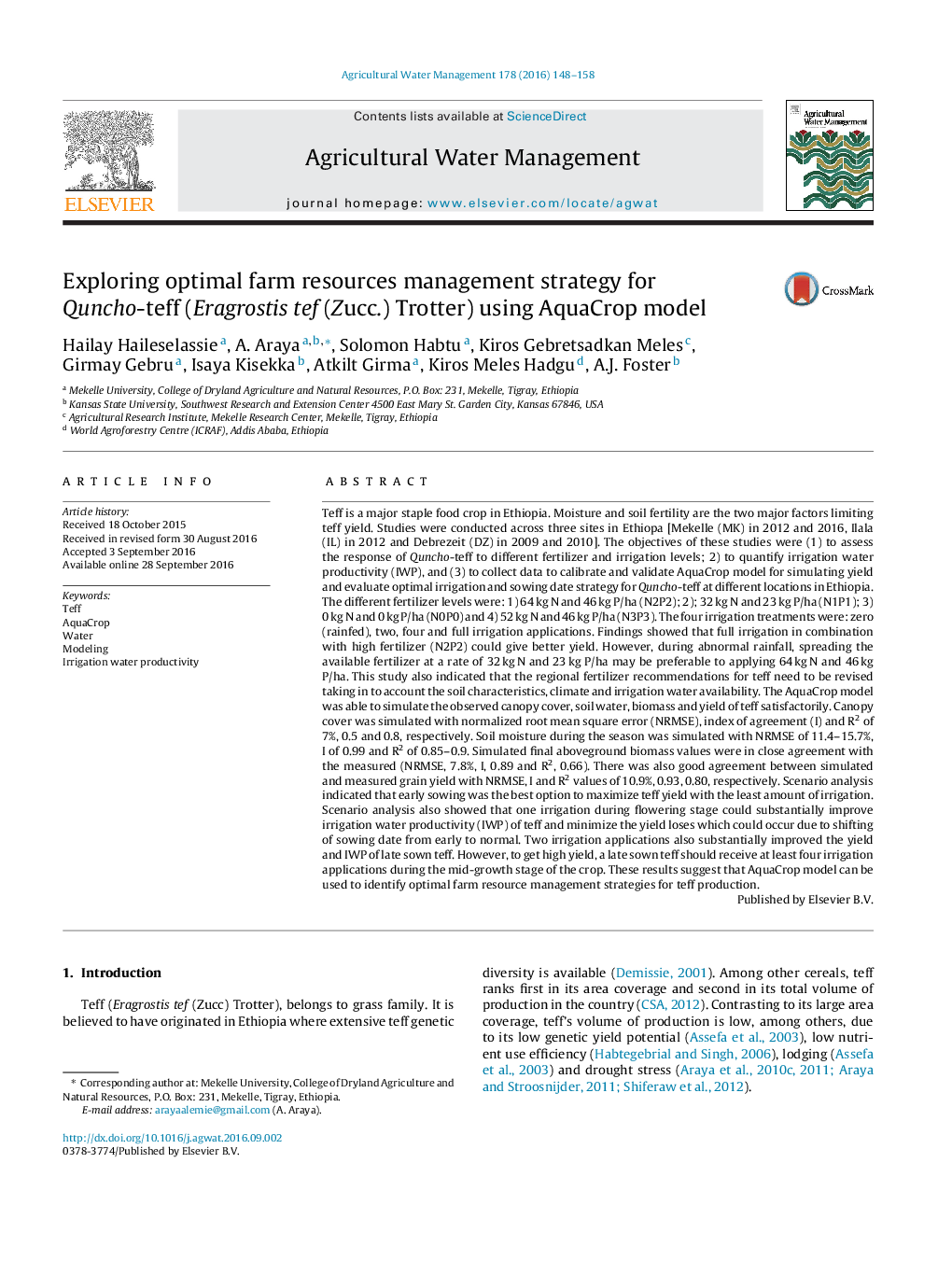| کد مقاله | کد نشریه | سال انتشار | مقاله انگلیسی | نسخه تمام متن |
|---|---|---|---|---|
| 6363325 | 1622902 | 2016 | 11 صفحه PDF | دانلود رایگان |

- Unlike previous findings, teff Normalized Water Productivity (NWP) fits to C4 crops.
- Teff yield and biomass responded well to high fertilizer and full irrigation.
- Early sowing was found to be the best strategy for growing teff in study area.
- Two irrigation applications also substantially improved the yield of late sown teff.
- This study suggests regional fertilizer recommendation for teff need to be revised.
Teff is a major staple food crop in Ethiopia. Moisture and soil fertility are the two major factors limiting teff yield. Studies were conducted across three sites in Ethiopa [Mekelle (MK) in 2012 and 2016, Ilala (IL) in 2012 and Debrezeit (DZ) in 2009 and 2010]. The objectives of these studies were (1) to assess the response of Quncho-teff to different fertilizer and irrigation levels; 2) to quantify irrigation water productivity (IWP), and (3) to collect data to calibrate and validate AquaCrop model for simulating yield and evaluate optimal irrigation and sowing date strategy for Quncho-teff at different locations in Ethiopia. The different fertilizer levels were: 1) 64 kg N and 46 kg P/ha (N2P2); 2); 32 kg N and 23 kg P/ha (N1P1); 3) 0 kg N and 0 kg P/ha (N0P0) and 4) 52 kg N and 46 kg P/ha (N3P3). The four irrigation treatments were: zero (rainfed), two, four and full irrigation applications. Findings showed that full irrigation in combination with high fertilizer (N2P2) could give better yield. However, during abnormal rainfall, spreading the available fertilizer at a rate of 32 kg N and 23 kg P/ha may be preferable to applying 64 kg N and 46 kg P/ha. This study also indicated that the regional fertilizer recommendations for teff need to be revised taking in to account the soil characteristics, climate and irrigation water availability. The AquaCrop model was able to simulate the observed canopy cover, soil water, biomass and yield of teff satisfactorily. Canopy cover was simulated with normalized root mean square error (NRMSE), index of agreement (I) and R2 of 7%, 0.5 and 0.8, respectively. Soil moisture during the season was simulated with NRMSE of 11.4-15.7%, I of 0.99 and R2 of 0.85-0.9. Simulated final aboveground biomass values were in close agreement with the measured (NRMSE, 7.8%, I, 0.89 and R2, 0.66). There was also good agreement between simulated and measured grain yield with NRMSE, I and R2 values of 10.9%, 0.93, 0.80, respectively. Scenario analysis indicated that early sowing was the best option to maximize teff yield with the least amount of irrigation. Scenario analysis also showed that one irrigation during flowering stage could substantially improve irrigation water productivity (IWP) of teff and minimize the yield loses which could occur due to shifting of sowing date from early to normal. Two irrigation applications also substantially improved the yield and IWP of late sown teff. However, to get high yield, a late sown teff should receive at least four irrigation applications during the mid-growth stage of the crop. These results suggest that AquaCrop model can be used to identify optimal farm resource management strategies for teff production.
Journal: Agricultural Water Management - Volume 178, December 2016, Pages 148-158